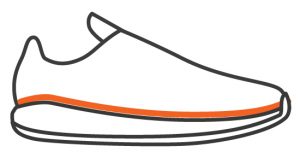What is a Kintec Approved Shoe?
At Kintec, our goal is to provide our customers with a selection of footwear to meet their varying needs. As a footwear company with a background in supportive medical devices such as orthotics and bracing, we take particular interest in carrying footwear that compliments the functionality of orthotics and other supportive medical devices. With that being said, we also aim to carry footwear to benefit active individuals like runners.
Here is some insight into what we look for in orthotic-friendly footwear.
What is Considered a Kintec Approved Shoe?

Removable Insole
Most shoes that have removable insoles will work with your custom orthotics. Simply remove the insoles that came in your shoes and insert our custom orthotics in their place.

Proper Flex-Point
Shoes need to work with your feet, not against them. Shoes should flex naturally at the ball of your foot, not in the middle.

Heel Support
The heel cup of your shoes should help support your feet. Squeeze the two sides of the heel cup together in your hand. The shoe should be fairly rigid and the two sides should not be able to touch. A shoe that squishes together easily will not keep your foot in place.

Torsional Stability
Grab a shoe with the heel in one hand and the forefoot in the other. Now twist in opposite directions. The shoe should only twist slightly. A shoe that collapses and bends too far will also collapse around your foot.

Comfort
At the end of the day, your comfort is the primary concern. Make sure you try on you shoes and walk around as much as possible.
Where Do Minimalist Shoes Fit In?
Minimalist shoes won’t have many of these characteristics. It doesn’t necessarily mean they are harmful, but they are not ideal for orthotics.
Minimalist shoes can be a great tool for building strength in your feet. However, this comes with a caveat – it isn’t suitable for everyone and for many people who do not have adequate biomechanics, should only wear them for a short period of time.
No Comments